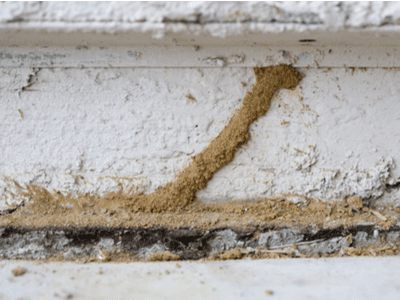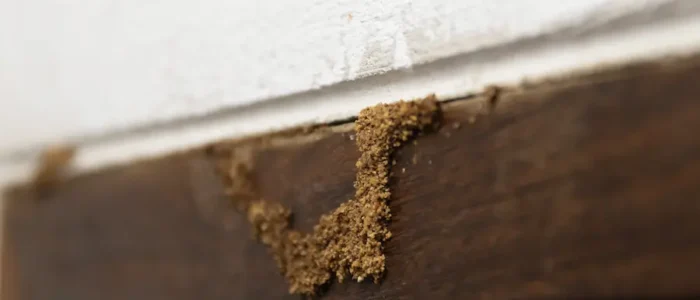In South Carolina, where our warm, humid climate creates the perfect breeding ground for termites, it’s crucial to stay vigilant. And at Gregory Pest Solutions, we understand the anxiety that comes with potential pest infestations that may be lurking behind your walls.
Termite infestations often start small and discreetly, but they can quickly escalate into a major problem. Their colonies can grow into the thousands or even millions as they seek new food sources and homes. While the signs won’t appear overnight, early detection is key to preventing extensive damage.
If you’re unsure whether you have a problem, we’re here to guide you through the telltale signs of termites in this guide. And as always, professional termite inspections (like ours at Gregory Pest Solutions) can help quickly identify any termite activity in your home or business.
7 Termite Signs
Remember, termites usually enter your home via a foundation crack or gap along a utility line. They seek out moist or rotted wood that is easy to chew and digest. Common places to find them are basements and crawl spaces where moisture has damaged the wood.

Here’s what to look out for when identifying termites:
- Mud tubes: These are tunnels made from mud and wood that termites use to travel into your home. They protect the colony as they move between their nest and food sources.
- Wall or ceiling damage: Keep an eye out for bubbling paint and blistering surface wood. Affected areas may sound hollow when tapped.
- Termite droppings: Not to be confused with sawdust, termites leave small piles of feces composed of wood pulp.
- Discarded wings: Once flying termites have established their new nest and selected a mate, they discard their wings. Finding discarded wings in or around your home could mean a new colony has moved in.
- Chewing or banging sounds: Put an ear to your wall. You may be able to hear the workers chewing the wood or the soldiers banging their heads in warning.
- Garden damage: If your termite nest began outside, you may notice damaged fencing or deck wood.
- Termite eggs and larvae: While usually well hidden deep inside the nest, you might come across eggs (tiny white or tan ovals found in clusters) or larvae (small white worms that resemble maggots).
The 3 Common Types of Termites in South Carolina
While there are thousands of termite species dating back to prehistoric times, there are three primary species you should be concerned about in South Carolina:
1. Subterranean Termites
As their name suggests, portions of their nest are usually underground. Subterranean termites have a more box-shaped head and feed on structural wood, making them particularly dangerous for homeowners.
Signs of subterranean termites include:
- Tunnels along the wood grain
- Mud tubes
- Underground nests
2. Formosan Termites
Known as the “super termites,” Formosan termites are the most destructive type found in the southeastern U.S. They tend to have larger nests than subterranean termites and, as a result, cause more damage once they move in. Formosan termites often have heads darker than their bodies.
Signs of Formosan termites include:
- Discarded wings
- Mud tubes
- Nests in walls
- Carton nests
3. Drywood Termites
Unlike other species, drywood termites feast on dry, solid wood-like furniture and can take years to become noticeable. They can be found in much of the southern U.S., including South Carolina.
Signs of drywood termites include:
- Hard waste pellets
- Pushout holes in wood
- Tunnels across the wood grain
What Do Termites Look Like?
Of course, one of the most obvious signs of termites is seeing them – but do you know what else to look for? These sneaky pests spend much of their time hidden away, making them easy to overlook. They’re often mistaken for ants, and it’s easy to confuse swarmers (termites with wings) with flying ants.
- Termites measure ⅛ -½ inch in length.
- They range in color from milky white to gold to dark brown, often with a translucent quality.
- Their appearance can vary depending on the species and caste.
- You can distinguish termites from other insects by their soft bodies, broad waists, and straight antennae.
Termite colonies are organized into three different castes:
- Workers: These are the most common termites and do the most damage. They use their strong mandibles to chew up wood for the cellulose that feeds the colony.
- Soldiers: These brave defenders protect the colony from ants and other invaders. They often have larger or darker heads with bigger mandibles than the workers.
- Swarmers (also known as alates): These are the flying termites that establish new colonies. Once they find a suitable location, they shed their wings and become the king and queen of the new colony. You can identify termites vs. flying ants by their uniform wing length – flying ants’ wings are uneven.

The Best Way to Get Rid of Termites
If you spot any of these signs, don’t panic – but do act quickly! Our team at Gregory Pest Solutions is just a phone call away, ready to provide expert termite detection services tailored to your South Carolina space.
While over-the-counter baits and traps might seem like a quick fix, they often lead to recurring problems. The most effective and long-lasting solution? Trusting termite experts, like Gregory Pest Solutions. With over 53 years of experience in South Carolina‘s unique climate and building styles, we’re equipped to:
- Pinpoint termite entry points
- Assess the extent of the infestation
- Develop a customized treatment plan
Depending on your specific situation, we may employ advanced solutions like the Sentricon baiting system or Termidor‘s cutting-edge termiticide. These professional-grade treatments offer long-term protection that at-home methods simply can’t match.
Contact Gregory Pest Solutions today to get started with a service quote. Let us give you the peace of mind you deserve, knowing your property is protected by the best in the business.
Back to Residential Termite Specialists
